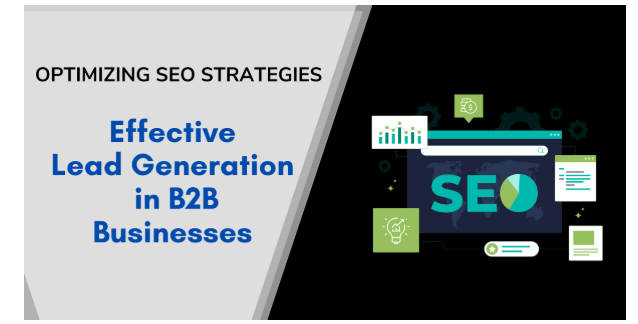In the competitive world of B2B marketing, generating high-quality leads is crucial for business growth. To stand out, it’s not just about ranking high in search results.
The key to optimizing SEO for lead generation is to attract the right audience and turn visitors into potential clients. In this post, we’ll explore how B2B businesses can harness SEO to boost their lead-generation efforts.
What is a B2B Business?
A B2B business (Business-to-Business) refers to companies that sell products or services to other businesses rather than individual consumers. B2B transactions typically involve larger-scale purchases, longer decision-making cycles, and multiple stakeholders. In these types of businesses, the focus is on establishing strong relationships and providing solutions that cater to specific business needs.
Examples of B2B Businesses:
- CRM Software Providers: Companies like Salesforce sell software to other businesses to help them manage customer relationships.
- Industrial Equipment Suppliers: A company selling machinery to manufacturers is a typical B2B model, where bulk purchases and long-term contracts are common.
- Marketing Agencies: A digital marketing agency offering services to other businesses like social media management, SEO, and content creation is another example of a B2B operation.
These businesses usually prioritize providing solutions that help other organizations streamline operations, increase revenue, or solve specific challenges.
What is Lead Generation?
Lead generation is the process of attracting potential customers (leads) to your business, engaging them, and nurturing them through various marketing tactics with the goal of converting them into paying clients. In the B2B context, lead generation focuses on identifying companies or decision-makers who need your product or service and guiding them through the sales funnel.
- Lead generation often involves multiple stages:
- Attracting leads through targeted content and SEO.
- Engaging leads with personalized offers, emails, or phone calls.
- Nurturing leads by providing them with valuable insights until they’re ready to make a purchase decision.
Examples of Lead Generation in B2B:
- Content Marketing: A B2B software company may offer downloadable whitepapers or eBooks that address common industry challenges. These resources are designed to attract leads who are searching for solutions.
- Email Campaigns: After a lead downloads a whitepaper, the company can send targeted emails offering webinars or demos to continue nurturing that lead toward a sale.
- Webinars: Hosting a live webinar that showcases your product’s features and provides value to the audience is another powerful way to generate leads and build trust with potential customers.
1. Understand the B2B Buyer Journey
B2B buyers typically go through a longer, more involved decision-making process than individual consumers. Understanding their journey is essential to crafting an SEO strategy that attracts and nurtures leads at every stage.
- Awareness Stage: Potential leads recognize a problem but are not yet familiar with solutions. They search for information to better understand their challenges.
- Consideration Stage: Leads begin evaluating potential solutions, researching different companies and products to address their needs.
- Decision Stage: Leads are ready to make a purchasing decision and are looking for proof of value, such as case studies, testimonials, or a demo.
Example: Let’s say a business is looking for a software solution to streamline its accounting. In the awareness stage, the buyer may search for “how to improve accounting efficiency.”
In the consideration stage, they might compare products with phrases like “best accounting software for small businesses.” By the time they reach the decision stage, they may search for “get a demo of [Software Name]” to make their final purchase decision.
2. Optimize for Long-Tail Keywords
For B2B businesses, ranking for broad keywords is tough and can be expensive. Instead, focus on long-tail keywords—longer, more specific search phrases that target users at the later stages of their decision-making process. These keywords are less competitive but can lead to higher-quality leads.
Example:
- Broad Keyword: “SEO services”
- Long-tail Keyword: “SEO services for SaaS businesses to increase lead generation”
Focusing on long-tail keywords helps attract leads who are actively searching for a solution tailored to their specific needs, making them more likely to convert into clients.
Actionable Tip: Use keyword research tools like Google Keyword Planner, Moz, or SEMrush to identify long-tail keywords that align with your audience’s specific needs.
3. Produce High-Quality, Value-Driven Content
Content is still king, especially in the B2B space. However, creating high-quality, value-driven content that speaks to your audience’s needs is key. By offering practical advice, addressing pain points, and providing educational resources, you build trust with your audience and keep them coming back.
Examples of Content Types:
- Case Studies: A company that provides CRM software can write a case study about how one of their clients improved their sales process with the help of the software.
- How-To Guides: A business that provides marketing automation tools could create a guide on “How to Optimize Email Campaigns for B2B Sales” to showcase their expertise.
- Industry Research: Publishing in-depth industry reports or research findings also positions you as an authoritative figure in your field.
Start by creating pillar pages—comprehensive, authoritative content that covers a broad topic. Then, link related blog posts or resources back to these pillar pages.
4. Leverage On-Page SEO for Lead Conversion
On-page SEO is not just about keywords; it’s about creating a user-friendly experience that leads visitors to take action. After attracting visitors through your content, you want to ensure that your website is optimized to convert those visitors into leads.
Key On-Page Elements:
- Meta Descriptions: Make sure your meta descriptions are compelling and contain relevant keywords to increase click-through rates.
- Clear Calls to Action (CTAs): Include prominent CTAs that guide visitors to take the next step, like “Schedule a Demo” or “Download our Free Guide.”
- Lead Capture Forms: Make it easy for visitors to share their information. Keep forms short and relevant to avoid overwhelming visitors.
Example: If a potential lead is reading your blog post about “Top B2B Marketing Strategies,” you could include a CTA at the end saying, “Want to boost your marketing efforts? Get a free consultation with our team today!”
5. Boost Your Website’s Technical SEO
To rank well and generate leads, your website needs to be fast, secure, and mobile-friendly. Technical SEO ensures that search engines can crawl and index your pages efficiently, while providing a seamless experience for users.
Actionable Tips:
- Page Load Speed: A slow website can hurt your rankings and user experience. Tools like Google PageSpeed Insights can help you optimize your website’s speed.
- Mobile Responsiveness: Ensure your website looks great and functions properly on mobile devices since a significant portion of B2B search traffic is from mobile.
- Secure Your Site (HTTPS): Google prefers secure websites, and customers trust them more.
6. Implement Effective Link-Building Strategies
Backlinks are an important ranking factor in SEO. They indicate that your website is authoritative and trustworthy. For B2B businesses, focus on building links from reputable sources within your industry, such as business directories, industry blogs, and other authoritative sites.
Example: A marketing agency might collaborate with industry influencers for guest blog opportunities or co-author content with other companies to earn backlinks.
7. Use Local SEO to Attract Local B2B Leads
If you serve a specific geographic area, local SEO can be a powerful tool for attracting local leads. By optimizing your website for local search terms and claiming your Google My Business listing, you can make it easier for local businesses to find your products or services.
Example: A web design agency in New York can optimize their website for keywords like “web design services New York” or “best NYC website design company.”
8. Track, Analyze, and Adjust Your SEO Efforts
To continuously improve your SEO efforts, you need to track and analyze your results. Google Analytics and other SEO tools can help you monitor your traffic, keyword rankings, and conversions, allowing you to adjust your strategies accordingly.
Actionable Tip: Set up goal tracking in Google Analytics to monitor how well your content and landing pages are converting visitors into leads.
Why is SEO so important for B2B Lead Generation?
1. Increased Visibility and Brand Awareness
The primary goal of SEO is to increase the visibility of your business in search engine results. For B2B companies, this means appearing in front of potential customers who are actively searching for solutions to their problems. When your business ranks higher on search engines like Google, it boosts your brand’s credibility and makes it easier for decision-makers to discover your services or products.
Example: Imagine a company that provides cybersecurity services for businesses. If their website ranks high for search terms like “best cybersecurity solutions for small businesses,” they’ll be discovered by companies looking for security services, increasing their visibility and creating opportunities for lead generation.
2. Targeted Traffic and High-Quality Leads
With SEO, you’re not just attracting anyone — you’re attracting people actively searching for the types of services you offer. By targeting specific, long-tail keywords that align with your audience’s needs, you can bring in highly qualified leads that are more likely to convert.
Example: A B2B software company providing project management tools might target long-tail keywords like “best project management software for construction companies.” This targets a specific group (construction companies) that would benefit from the product, rather than just attracting anyone interested in project management tools in general.
By focusing on the right keywords, you’re filtering out irrelevant traffic and ensuring that those who visit your website are more likely to be in the decision-making process.
3. Builds Trust and Credibility
EcoSEO mentioned to us that SEO isn’t just about keywords — it’s also about providing valuable, relevant content that answers your audience’s questions and solves their problems. When you produce high-quality content like blog posts, case studies, and guides, you establish your authority in your industry. This builds trust with potential leads, making them more likely to consider your services.
Example: A company that offers HR consulting services might publish detailed guides on how to handle employee retention or workplace compliance. Not only does this provide value, but it positions the company as an expert in the field, helping potential clients trust that they can solve their business challenges.
4. Supports the Entire Buyer’s Journey
SEO helps guide leads through all stages of the buyer’s journey — from the initial research phase to the decision-making process. By creating content tailored to each stage (awareness, consideration, decision), B2B businesses can nurture their leads and stay top-of-mind.
Example: A potential lead may start by searching for “how to improve team collaboration” in the awareness stage. In the consideration stage, they might search for “best collaboration tools for teams.” Finally, in the decision stage, they might search for “buy collaboration software for teams.” If your SEO strategy is on point, your business can appear in search results at every stage, gradually guiding the lead to make a purchase decision.
5. Cost-Effective Lead Generation
Compared to paid advertising, SEO is one of the most cost-effective methods for lead generation. While paid ads can give you immediate visibility, the costs can add up quickly. SEO, on the other hand, allows you to attract organic traffic without continuous spending.
Example: A small B2B business with a limited marketing budget can invest in SEO to get organic traffic from search engines over time, reducing reliance on expensive ads while still generating quality leads.
6. Competitive Advantage
Many B2B companies still haven’t fully optimized their SEO efforts. By improving your search rankings, you can gain a competitive edge and stand out from other businesses in your industry. High search rankings can position your brand as an industry leader, making you the first choice for businesses seeking solutions.
Example: If you’re a digital marketing agency that focuses on SEO, you might want to rank for terms like “best SEO agencies for B2B businesses.” If you rank at the top for that term, businesses searching for SEO services for B2B models will be more likely to click on your link, giving you an advantage over competitors.
7. Improves Conversion Rates
While SEO brings traffic, the true magic happens when your website is optimized for conversions. Good SEO practices include having clear calls-to-action (CTAs), fast-loading pages, mobile-friendly design, and lead capture forms that make it easy for prospects to take the next step. All of these factors combined can help convert visitors into leads.
Example: If your website has an informative blog about content marketing for B2B companies, including an easily accessible “Contact Us” or “Request a Demo” form on that page, you can convert readers into qualified leads who are interested in your services.
8. Better User Experience
SEO is not just about ranking higher — it’s also about delivering a better user experience (UX). Google rewards websites that load fast, are easy to navigate, and provide valuable content. This means that optimizing your website for SEO often leads to a better overall experience for your potential leads, encouraging them to stay longer and engage more with your business.
Example: A potential lead visits your website but is frustrated by slow load times or a confusing navigation system. They’re likely to bounce off your site and go elsewhere. On the other hand, a well-optimized, fast, and user-friendly site keeps visitors engaged and encourages them to take action.
Conclusion
Effective SEO for B2B lead generation requires a strategic approach that aligns with the buyer’s journey, focuses on the right keywords, and creates high-value content.
By optimizing your website and content for both search engines and your audience, you can attract high-quality leads that are more likely to convert into long-term clients. Keep analysing your results, fine-tuning your approach, and stay consistent, and you’ll see measurable growth in your lead generation efforts.
FAQ
What is B2B lead generation?
B2B lead generation refers to the process of attracting, nurturing, and converting potential business clients into paying customers. This process involves multiple tactics such as content marketing, SEO, email outreach, and webinars to identify and engage leads.
How long does it take to see results from B2 BSEO?
Typically, SEO for B2B businesses take around 3-6 months to show significant results, depending on factors like competition, website optimization, and keyword difficulty. The key is to stay consistent and track your progress regularly.
How do I know which keywords to target for B2B SEO?
Start by researching keywords that align with your audience’s needs. Tools like Google Keyword Planner, SEMrush, or Moz can help you identify long-tail keywords that are relevant to your business and less competitive.
Can SEO help with local lead generation?
Yes, optimizing your website for local SEO can attract leads from businesses in your geographic area. By focusing on local keywords and setting up a Google My Business profile, you can improve your visibility in local search results.
What types of content work best for B2B lead generation?
Content like case studies, how-to guides, and industry research reports work well in B2B lead generation. Offering valuable insights, addressing specific pain points, and providing actionable solutions helps build trust and move leads through the sales funnel.
Read More From Techbullion



































